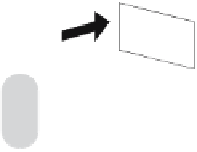Biomedical Engineering Reference
In-Depth Information
Fig. 2.2.
A device with e
cient energy transfer from an airflow to moving parts so
as to produce a self-sustained oscillation at an audible frequency: in other words, a
paper whistle. The physics behind this device is similar to that of the oscillation of
the human vocal cords and of the avian labia, and is like that of the paper sheets
in Fig. 2.1c. In contrast, an ordinary whistle emits sound in much the same way as
a flute (Fig. 2.1b)
2.2 Filters and Resonances
2.2.1 Same Source, Different Sounds
We have discussed the fact that a perturbation in the air density can give
rise to a propagative phenomenon. The displacements induced at a point in
an air mass as a perturbation arrives are capable of performing work (such as
moving the membrane of a microphone, for example). We have also discussed
how to generate the original perturbations that will eventually propagate: one
way is to establish a time-varying airflow. We still need to discuss another
element of importance: the role of passive filters.
In many cases the sound, after being generated, and before propagating
freely in the atmosphere, passes through a bounded region of space. The
geometry and other characteristics of that region will impose a signature on
the sound finally emitted. An example close to us all is the case of the human
voice. If you put your hand on your neck, close to the larynx, while you
pronounce a vowel, you will feel a vibration. The vibration is produced by
oscillations of the vocal folds, which in turn are induced by an airflow from
the lungs. This is a sound source whose dynamical nature is very similar to
that of the example of the parallel pieces of paper that oscillate when air
is blown between them. However, in the case of the vowels, we know that
the sound can change dramatically according to where we place our tongue
as we vocalize, even if we do not change the oscillation conditions of the
vocal folds. In fact, these sounds can be so different that we make them
different “vowels”. They are just sounds produced with the same source (the
vocal cords), but with the configuration of the
filter
changed by moving the
tongue, lips, etc. [Titze 1994].









